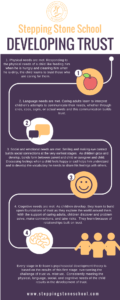Developing Trust

Developmental psychologist Erik Erikson was best known for his theory of psychosocial development. He identified the first stage in this model astrust vs. mistrust beginning in infancy until approximately 18 months. During this time in a child’s life, he will learn he can trust those caring for him based on their consistent care meeting his needs and responding to his cries. According to Erikson, success in this stage leads to the virtue of hope – when the same child encounters uncertainty in the future, he has hope that he will be successful because he knows those who care for him will be there to support him.
This month, Stepping Stone School will focus on the idea of trustworthiness. Developing an attitude of trust, being trustworthy, and building trust with one another. Through responsive caregiving, our teachers use care for children in a manner which supports trust.
- Physical needs are met. Responding to the physical needs of a child like feeding him when he is hungry and cleaning him when he is dirty,the child learns to trust those who are caring for them.
- Language needs are met. Caring adults learn to interpret children’s attempts to communicate their needs, whether through cries, coos, signs, or actual words and this communication builds trust.
- Social and emotional needs are met. Smiling and making eye contact builds social connections at the very earliest stages. As children growand develop, bonds form between parent and child or caregiver and child. Discussing feelings when a child feels happy or sad helps him understand and to develop the vocabulary he needs to share his feelings with others.
- Cognitive needs are met. As children develop, they learn to build upon foundations of trust as they explore the world around them. With the support of caring adults, children discover and problem solve, make connections, and take risks. They learn because of relationships built on trust.


Every stage in Erikson’s psychosocial development theory is based on the results of this first stage: overcoming the challenge of trust vs. mistrust. Consistently meeting the physical, language, social, and cognitive needs of the child results in the development of trust.

Resources: